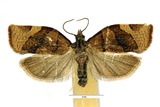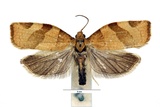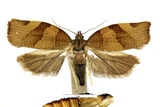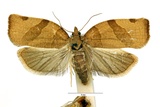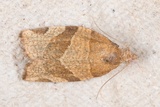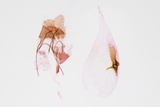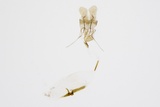Pandemis cerasana (Hübner, 1786) Species
Last modified: Nov. 8, 2023, 12:35 p.m.
A very common, and also very variable species throughout Belgium.
Details
- Classification
- Family: Tortricidae > Subfamily: Tortricinae > Tribus: Archipini > Genus: Pandemis > Species: Pandemis cerasana
- Vernacular names
- Kersenbladroller (NL), Barred Fruit-tree Tortrix (EN), la Tordeuse du cerisier (FR), Johannisbeerwickler (DE)
- Synonyms
- Pandemis ribeana (Hübner, 1799)
- First mention in Belgium
- De Sélys-Longchamps E. 1844. Énumération des insectes Lépidoptères de la Belgique. — Mémoires de la Société royale des Sciences de Liége 2: 1–35. On page 20.
- Status
-
Native
Distribution
Imago
Wingspan 16–25 mm.
Sexual dimorphism not pronounced. Antenna of male weakly dentate-ciliate with a distinctive notch at the base . Antenna of female sparsely ciliate. Male with modified dark scales on the ventral surface of abdominal segments 2–3. Forewing of costa curved to almost one-half in male, just to one-quarter in female.
Forewing ground colour yellowish brown, weakly strigulate distally. Markings reddish brown, consisting of an almost straight basal fascia, a transverse fascia at one-half costa to two thirds dorsum and a triangular costal blotch at three-quarters of costa. The median fascia diverges from the outer margin of the basal fascia and is often bulging slightly centrally. Hindwing almost uniform greyish brown. Basal ciliary line concoulorous; outer cilia paler.
Underside of forewing brown, paler towards termen and usually with a medial pale patch on costa. Hindwing underside pale fuscous to fuscous, tending to cream along costa.
Caterpillar
Late instar larvae with light green head and prothoracic plate with conspicuous black posterolateral markings. Abdomen light green, unmarked, with moderately large pinacula and long yellowish white setae. Large oval spiracles on the prothoracic and the eight abdominal segment conspicuous. Anal plate light green, spotted with black; a well-developed yellowish anal comb with 6–8 prongs present.
Cocoon/pupa
Length 11–15 mm. Brown to brownish black, darker dorsally. Cremaster long and narrow.
Bionomics
Eggs deposited in small batches on leaves or branches, some hatching in late summer, others overwintering and hatching in spring. Overwintering takes place in an early instar in silken hibernacula on twigs.
The larvae are feeding in a rolled or folded leaf. Pupation takes place in a whitish cocoon in a folded leaf or in the larval habitation.
The adults fly actively at dusk and frequently come to light.
Flight periods
In Belgium the adults fly in a single generation from early May to end September. In more Southern regions in Europe the species flies in 2 generations.
Observed on
- Substrates:
- Polyphagous
The species is highly polyphagous, feeding predominantly on broad-leaved trees, including fruit trees of all kinds. Important pest species in Apple, Pear and Cherry gardens.
